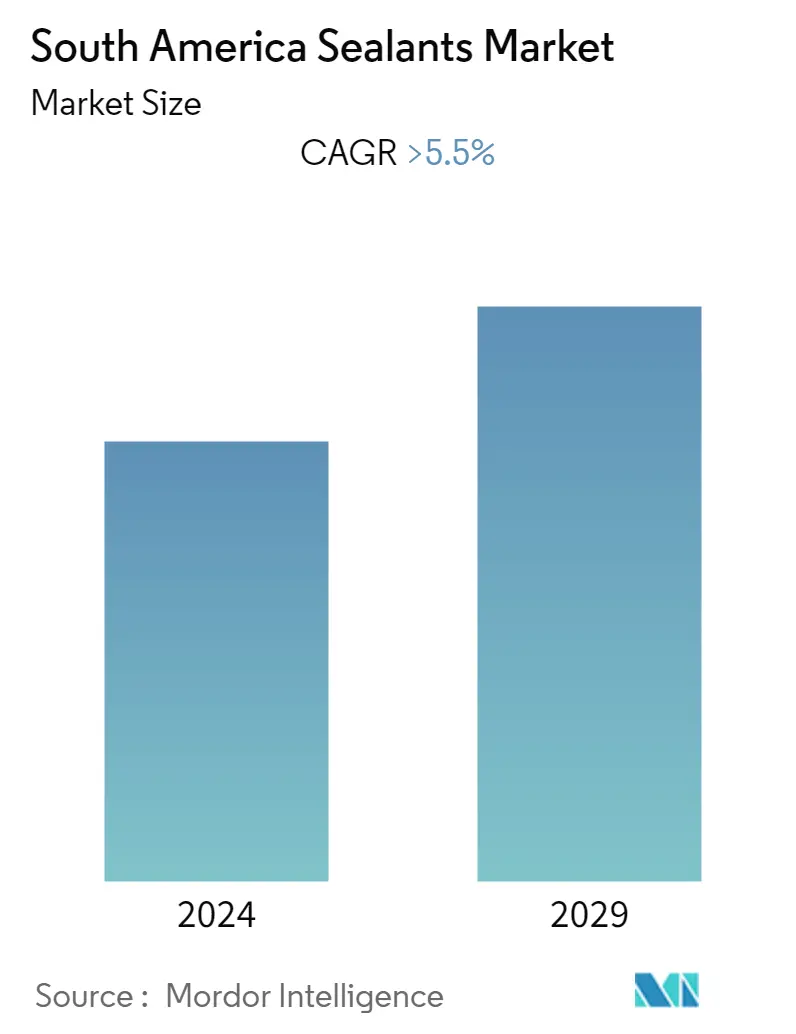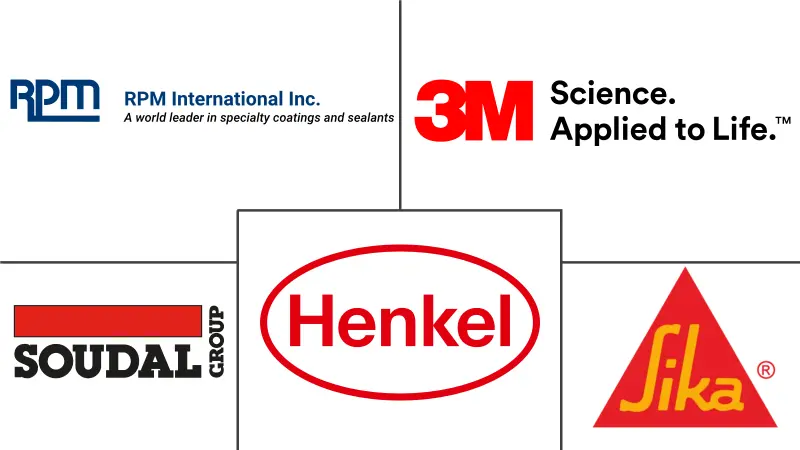Market Size of South America Sealants Industry

| Study Period | 2019 - 2029 |
| Base Year For Estimation | 2023 |
| Forecast Data Period | 2024 - 2029 |
| Historical Data Period | 2019 - 2022 |
| CAGR | 5.50 % |
| Market Concentration | Low |
Major Players
*Disclaimer: Major Players sorted in no particular order |
South America Sealants Market Analysis
The South America Sealants market is expected to reach a value of around USD 490 million by the end of this year and is projected to register a CAGR of more than 5.5% during the forecast period. COVID-19 negatively impacted the market in 2020. However, the market has now been estimated to have reached pre-pandemic levels and is forecasted to grow steadily.
- The expanding building and construction industry will likely drive the market significantly in the coming years.
- However, the strict regulations on the usage of VOC-free content are expected to hinder the market's growth.
- Increasing awareness of renewable and eco-friendly products is expected to be an opportunity.
South America Sealants Industry Segmentation
Sealant is a substance that is used to prevent fluids from passing through gaps in materials. Sealants are widely used in several industries, such as automotive, construction, electronics, and others owing to their properties such as waterproofing, crack sealing, weather sealing, etc. The South American sealants market is segmented by end-user industry, resin type, and geography. By end-user industry, the market is segmented into aerospace, automotive, building and construction, healthcare, and other end-user industries. By resin type, the market is segmented into acrylic, epoxy, polyurethane, silicone, and other resin types. By geography, the market is segmented into Argentina, Brazil, and the rest of South America. The report also covers the market size and forecasts for the market in 2 countries across the region. For each segment, the market sizing and forecasts have been done on the basis of volume (kiloton) and revenue (USD million).
| End-User Industry | |
| Aerospace | |
| Automotive | |
| Building and Construction | |
| Healthcare | |
| Other End-user Industries |
| Resin Type | |
| Acrylic | |
| Epoxy | |
| Polyurethane | |
| Silicone | |
| Other Resin Types |
| Geography | |
| Argentina | |
| Brazil | |
| Rest of South America |
South America Sealants Market Size Summary
The South America sealants market is poised for steady growth, driven primarily by the burgeoning building and construction industry. Sealants are integral to construction due to their ability to prevent the passage of liquids and other substances through material surfaces, making them essential for applications such as sub-flooring, structural glazing, and HVAC systems. The market has rebounded to pre-pandemic levels after the setbacks caused by COVID-19, with Brazil leading the demand due to its large-scale construction projects and automotive industry. The region's focus on renewable and eco-friendly products presents new opportunities, despite challenges posed by stringent regulations on VOC-free content.
The market landscape in South America is characterized by fragmentation, with key players like 3M, RPM International, Sika AG, Soudal Holding N.V., and Henkel AG & Co. KGaA actively participating. Brazil's commitment to reducing emissions and its growing number of certified green buildings are expected to further drive the demand for sealants, particularly silicone sealants used in structural glazing for energy efficiency. Recent expansions and product innovations by companies such as WACKER and collaborations like that between Ashland Technology and Henkel AG highlight the dynamic nature of the market, setting the stage for continued growth and development in the coming years.
South America Sealants Market Size - Table of Contents
-
1. MARKET DYNAMICS
-
1.1 Market Drivers
-
1.1.1 Rising Demand from Building and Construction Sector
-
1.1.2 Other Drivers
-
-
1.2 Market Restraints
-
1.2.1 Strict Regulations on the Usage of VOC-free Contents
-
1.2.2 Other Restraints
-
-
1.3 Industry Value Chain Analysis
-
1.4 Porter's Five Forces Analysis
-
1.4.1 Threat of New Entrants
-
1.4.2 Bargaining Power of Buyers/Consumers
-
1.4.3 Bargaining Power of Suppliers
-
1.4.4 Threat of Substitute Products
-
1.4.5 Degree of Competition
-
-
-
2. MARKET SEGMENTATION (Market Size in Value and Revenue)
-
2.1 End-User Industry
-
2.1.1 Aerospace
-
2.1.2 Automotive
-
2.1.3 Building and Construction
-
2.1.4 Healthcare
-
2.1.5 Other End-user Industries
-
-
2.2 Resin Type
-
2.2.1 Acrylic
-
2.2.2 Epoxy
-
2.2.3 Polyurethane
-
2.2.4 Silicone
-
2.2.5 Other Resin Types
-
-
2.3 Geography
-
2.3.1 Argentina
-
2.3.2 Brazil
-
2.3.3 Rest of South America
-
-
South America Sealants Market Size FAQs
What is the current South America Sealants Market size?
The South America Sealants Market is projected to register a CAGR of greater than 5.5% during the forecast period (2024-2029)
Who are the key players in South America Sealants Market?
Henkel AG & Co. KGaA,, RPM International, 3M, Sika AG and Soudal Holding N.V. are the major companies operating in the South America Sealants Market.

